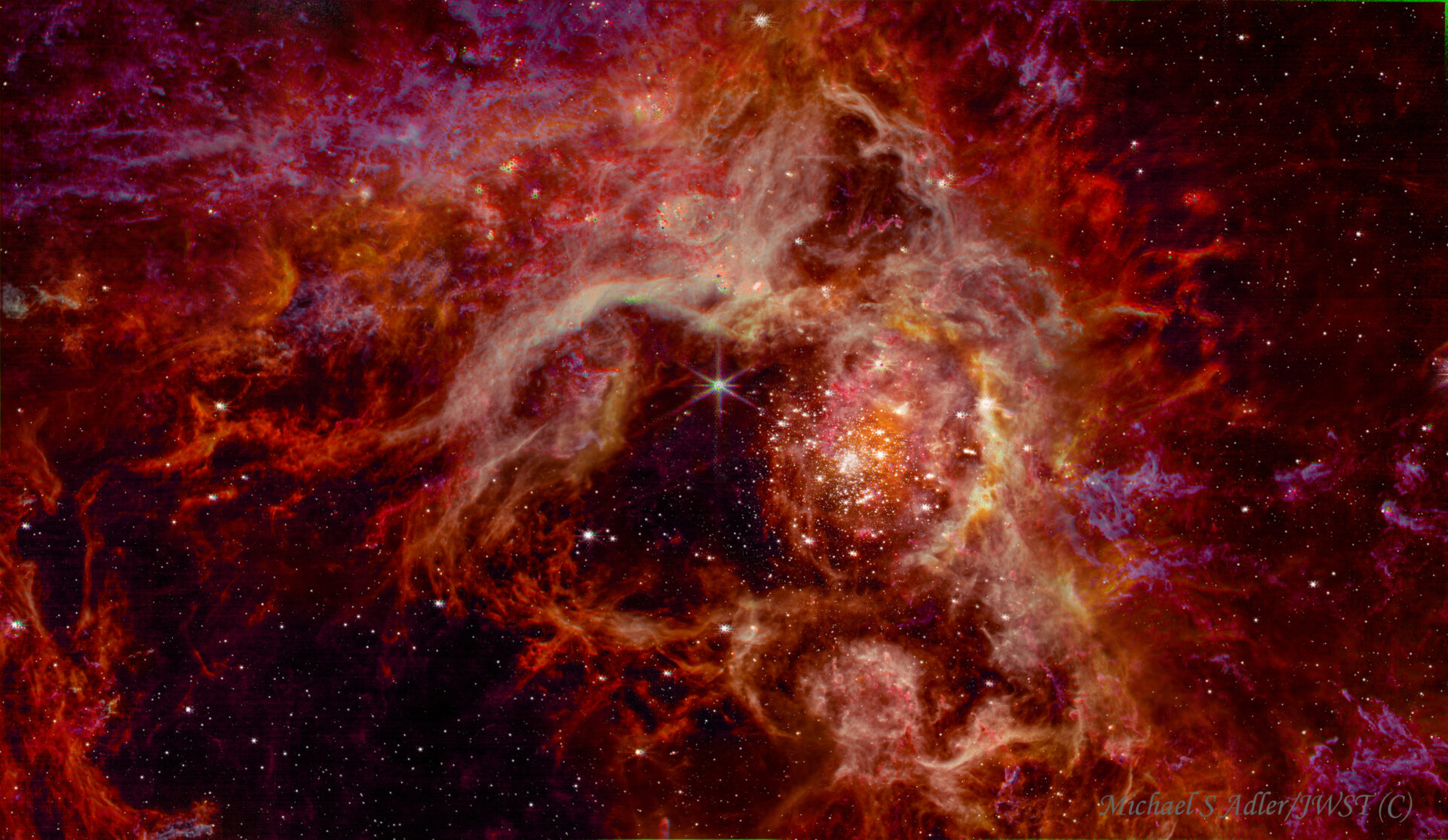Optics: James Webb Space Telescope(JWST)
Mount: JWST
Camera:NIRCAM(JWST Near Infrared Camera)
Filters: 470n,444w,335m
Dates/Times: July 2022
Location: Lagrange Point 2 orbit, ~1 million miles from Earth
Exposure Details: Six near infrared filters on the JWST NIRCAM ranging from 900nm to 4700nm
Acquisition: Downloeaded from the MAST website(Mikulski Archive For Space Telescopes)
Processing:FITS Liberator was used to stretch the images and MaximDl was used to align the data from the three filters and create the three wavelength color image created from the 470w(red),444w(green), and 335m(blue) filters. Final processing done in PS 2022 and Camera Raw.
Tarantula Nebula, NGC 2070, JWST
Original price was: $65.00.$52.50Current price is: $52.50.
Tarantula Nebula, JWST, NGC 2070 The Tarantula Nebula is more than a thousand light-years in diameter, a giant star forming region within nearby satellite galaxy the Large Magellanic Cloud. It is located at a declination of -69 degrees which is the celestial version of latitude and is only visible from the Southern Hemisphere. About 180 thousand light-years away, it’s the largest, most violent star forming region known in the whole Local Group of galaxies. This distance is further away than any part of the Milky Way itself which is 110 thousand light years in size. Astronomers focused three of Webb’s high-resolution infrared instruments on the Tarantula. Viewed with Webb’s Near Infrared Camera(NIRCam) the region resembles a burrowing tarantula’s home, lined with its silk. The nebula’s cavity centered in the NIRCam image has been hollowed out by blistering radiation from a cluster of massive young stars, which sparkle pale blue in the image. Only the densest surrounding areas of the nebula resist erosion by these stars’ powerful stellar winds, forming pillars that appear to point back toward the cluster. These pillars contain forming protostars, which will eventually emerge from their dusty cocoons and take their turn shaping the nebula. Webb’s Near-Infrared Spectrograph(NIRSpec) caught one very young star, the bright one in the center of the image, doing just that. Astronomers previously thought this star might be a bit older and already in the process of clearing out a bubble around itself. However, NIRSpec showed that the star was only just beginning to emerge from its pillar and still maintained an insulating cloud of dust around itself. Without Webb’s high-resolution spectra at infrared wavelengths, this episode of star formation-in-action could not have been revealed. This image was done through three near infrared filters at 4.7u, 4.44u, and 3.35u with the red, green, and blue(R,G,B) colors in the image coming from light with the wavelengths in the order listed. Thus the orange color dominating the image is a mix of the light from the 4.7u and 4.44u filters. For comparison the center of the visible spectrum is 0.5u, almost 10X shorter wavelength. The longer wavelengths allow the Webb to probe more deeply into the nebula.
The full view of the Tarantula Nebula can be seen in my image done with the 17″ CDK17 telescope in Rio Hurtado, Chile. https://earthandskyimaging.com/product/tarantula-nebula-ngc-2070-2/. The JWST image location is just right of the center of this larger image where the star cluster and the small hole in the nebula can be seen. The rich field of this large view spans about 1 degree or 2 full moons, in the southern constellation Dorado. But were the Tarantula Nebula closer, say 1,500 light-years distant like the local star forming Orion Nebula it would take up half the sky.


